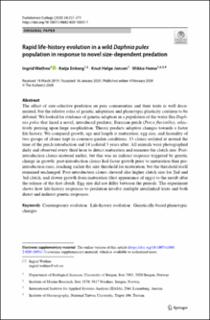| dc.description.abstract | The effect of size-selective predation on prey communities and their traits is well documented, but the relative roles of genetic adaptation and phenotypic plasticity continue to be debated. We looked for evidence of genetic adaption in a population of the water flea Daphnia pulex that faced a novel, introduced predator, Eurasian perch (Perca fluviatilis), selectively preying upon large zooplankton. Theory predicts adaptive changes towards a faster life history. We compared growth, age and length at maturation, egg size, and fecundity of two groups of clones kept in common-garden conditions, 13 clones isolated at around the time of the perch introduction and 14 isolated 3 years after. All animals were photographed daily and observed every third hour to detect maturation and measure the clutch size. Post-introduction clones matured earlier, but this was an indirect response triggered by genetic change in growth: post-introduction clones had faster growth prior to maturation than pre-introduction ones, reaching earlier the size threshold for maturation, but the threshold itself remained unchanged. Post-introduction clones showed also higher clutch size for 2nd and 3rd clutch, and slower growth from maturation (first appearance of eggs) to the moult after the release of the first clutch. Egg size did not differ between the periods. The experiment shows how life-history responses to predation involve multiple interlinked traits and both direct and indirect genetic responses. | en_US |
